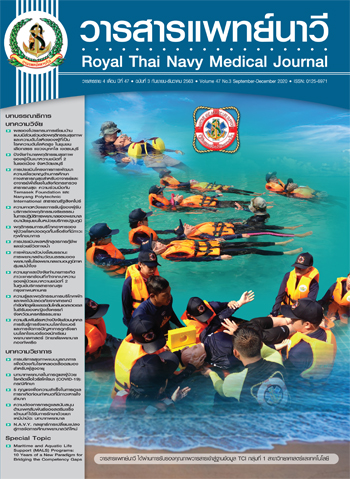Prevalence and Factors Predicting Diabetic Foot among Type 2 Diabetes Mellitus Patients in Public Health Centers, Bangkok Metropolitan
Main Article Content
Abstract
This research aimed to explore diabetic foot prevalence and to study factors predicting diabetic foot among type 2 diabetes mellitus patients. For exploring diabetic foot prevalence, data were collected by chart reviews from 1,084 samples receiving health care services from public health centers, Bangkok Metropolitan. For studying factors predicting diabetic foot, data were collected by self-reported questionnaires from 140 samples. Data were analyzed using descriptive statistics and logistic regression analysis. The results revealed that diabetic foot prevalence was 302 cases per 1000 people. Significant factors that predicted diabetic foot were duration of having diabetes (OR = 1.767, 95% CI: 1.364 - 2.290), health behavior (OR = .868, 95% CI: 798 - .945), health literacy (OR = .931, 95% CI: .892 - .971), and hemoglobinA1c (OR = 2.062, 95% CI: 1.074 - 3.958). All factors could predict diabetic foot by 67% (R2 = .667)
Nurse practitioners and other health care providers who took care of type 2 diabetes mellitus patients could bring information from this study to design interventions for caring patients. The interventions should focus on helping patients be able to control their hemoglobinA1c, promoting healthy behavior, enhancing appropriate health literacy, especially for those who had long duration of diabetes in order to prevent or delay diabetic foot.
Article Details

This work is licensed under a Creative Commons Attribution-NonCommercial-NoDerivatives 4.0 International License.
References
Kosachunhanun N. Prevention and management of the diabetic foot. Chiang Mai: Faculty of Medicine Chiang Mai University; 2013. (in Thai).
Chanasrirattanakul W. Selected factors related to quality of life in patients with diabetic foot ulcer, Northeast region. Journal of Nursing Science Chulalongkorn University 2013;25(2):41-53. (in Thai).
Pianpraingam K, Navicharern R. Factors related to quality of life of patients with diabetic foot ulcers treated at health ministry hospitals in the upper northern region. Journal of Nursing Science Chulalongkorn University 2012;24(3):16-27. (in Thai).
Zhang P, Lu J, Jing Y, Tang S, Zhu D, Bi Y. Global epidemiology of diabetic foot ulceration: a systematic review and meta-analysis (dagger). Ann Med 2017;49(2):106-16.
Department of Disease Control. Annual epidermiological surveillance report 2018. [Internet]. [cited 2019 June 7 ]. Available from: https://apps.boe.moph.go.th/boeeng/download/AW_Annual_Mix%206212_14_r1.pdf. (in Thai).
Phuwong Y, Pinitsoontorn S. Complication among diabetes patients in a selected community hospital in the northeast. Community Health Development Quarterly Khon Kaen University 2014;2(3):311-9. (in Thai).
Almobarak AO, Awadalla H, Osman M, Ahmed MH. Prevalence of diabetic foot ulceration and associated risk factors: an old and still major public health problem in Khartoum, Sudan?. Ann Transl Med 2017;5(17):340. doi:10.21037/atm.2017.07.01.
Obaid H, Eljedi A. Risk factors for the development of diabetic foot ulcers in Gaza strip: A case-control study. Int J Diabetes Res 2015;4(1):1-6. doi:10.5923/j.diabetes.20150401.01.
Choeisuwan V, Borisudtum N, Muntha S. Prevalence of diabetic foot ulcers and related factors in diabetes patients at out-patient department, Somdech Phra Pinklao hospital. Royal Thai Navy Medical Journal. 2016;43(1):1-16. (in Thai).
Zubair M, Ahmad J. Heat shock protein 70 gene single nucleotide polymorphism and diabetic foot ulcer. Is there any relationship?. J Clin Med 2018;7(8):1-11. doi: 10.3390/jcm 7080187.
Coster S, Gulliford MC, Seed PT, Powrie JK, Swaminathan R. Monitoring blood glucose control in diabetes mellitus: a systematic review. Health Technol Assess (Winchester, England) 2000;4(12):i-iv,1-93.
Mariam TG, Alemayehu A, Tesfaye E, Mequannt W, Temesgen K, Yetwale F, et al. Prevalence of diabetic foot ulcer and associated factors among adult diabetic patients who attend the diabetic follow-up clinic at the University of Gondar Referral Hospital, North West Ethiopia, 2016: institutional-based cross-sectional study. J Diabetes Res 2017;2017:2879249. doi: 10.1155/2017/2879249.
Watts SA, Stevenson C, Adams M. Improving health literacy in patients with diabetes. Nursing 2017;47(1):24-31. doi: 10.1097/01.NURSE.0000510739.60928.a9.
Seelacharoen N. Relative factors for diabetic foot ulcers patients in diabetic mellitus type 2 in Doembangnangbuat district, Suphanburi province. Journal of the Department of Medical 2017;42(3):85-95. (in Thai).
Lohsoonthorn V. Epidermiology. Bangkok: Chulalongkorn University; 2018. (in Thai).
Prasat Neurological Institute. Cognitive screening test Thai Mental State Examination. Clinical practice guidelines: Dementia. Bangkok: Thana Press; 2014. (in Thai).
Srisatidnarakul B. The methodology in nursing research. 5th ed. Bangkok: U & I Inter Media; 2010. (in Thai).
Peduzzi P, Concato J, Kemper E, Holford TR, Feinstein AR. A simulation study of the number of events per variable in logistic regression analysis. J Clin Epidemio 1996;49(12):1373-9. doi :10.1016/S0895-4356(96)00236-3.
Institute of Medical Research and Technology Assessment. Clinical practice guideline prevention and management of diabetic foot complications. [Internet]. [cited 2020 July 27]. Available from: http://www.imrta.dms.moph.go.th/imrta/images/cpg2013-1.pdf. (in Thai).
Health Education Division, Department of Health Service Support. Ministry of Public Health. Strategies for promoting health literacy and health behavior. Bangkok: Health Education Division; 2018. (in Thai).
Sriklo M, Khungtumneam K, Buajaroen H. Effects of foot care promoting program on perceived empowerment and foot care behaviors of patients with diabetes mellitus type 2 at Tambon Bann Klongsuan Health Promoting Hospital, Samut Prakarn province. Journal of Boromarajonani College of Nursing, Bangkok 2014;30(2):68-79. (in Thai).
Kaeoumkoeng K. Health literacy: access, understand and application. 2th ed. Bangkok: Amarin Printing and Publishing; 2018. (in Thai).
Al-Kaabi JM, Maskari FA, Zoubeidi T, Abdulle A, Shahs M, Cragg P, et al. Prevalence and determinants of peripheral neuropathy in patients with type 2 diabetes attending a tertiary care center in the United Arab Emirates. Diabetes and Metabolism 2014;5(3):1-7.
Ovatakanont P. The outcome of diabetes care and factors associated with poor glycemic control among type 2 diabetic patients in Saimun hospital. Srinagarind Medical Journal 2011;26(4):339-49. (in Thai).
Bohanny W, Wu SF, Liu CY, Yeh SH, Tsay SL, Wang TJ. Health literacy, self-efficacy, and self-care behaviors in patients with type 2 diabetes mellitus. J Am Assoc Nurse Pract 2013;25(9):495-502. doi: 10.1111/1745-7599.12017.


